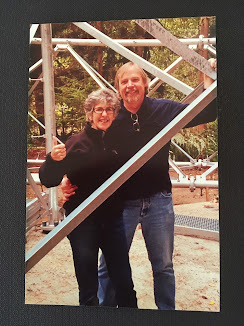This week's post comes from my 2017 book Surely Joy, for which it served as the final, then-unpublished essay. I've never posted it online, but--over the past two weeks, listening to the disparate visions of America presented by the two political conventions--I started thinking about my experience growing up in suburbia, which I captured in this essay. I live in the city again, but my recent time in a Seattle suburb showed me how much things have changed since my childhood.
I'll be taking a break from posting until after Labor Day. Please be well and enjoy the fleeting days of this weird summer. -- Julie
My parents were two city kids who’d hailed from Chicago, a Cubs fan and a White Sox partisan who somehow got together. Like most white folks of their generation, they moved to the suburbs after Dad came back from the big war. Unlike many, they never became afraid to venture back into the city: for ball games, traveling Broadway shows, and even to see Billie Holiday sing in a little club on the South Side.
Dad’s company transferred my parents to Pittsburgh when I was four, and while I grew up in a suburban subdivision so lily-white it was actually named Plantation Place, I knew people of color. My favorite memories are of Zola, the woman who ran the inner-city preschool where my fair-skinned mother volunteered once a week, where Mom was known as “the brownie lady” for the pan of treats she brought along every Tuesday morning. One time, Mom and Dad invited Zola and her husband to dinner. We all ate on the side porch of our home, and the four adults laughed there late into the night. The next day, I learned from a neighborhood friend she would not be allowed to play at our house anymore.
I loved the woods and meadows and creeks of southwestern Pennsylvania, the same landscapes that inspired Rachel Carson. But I was drawn to the city, and as soon as I got old enough to travel on my own, I’d take the trolley to downtown and a bus to Oakland, where the colleges and museums and rock clubs were. I’d wander for hours on foot, up Forbes and Centre, imagining what it would be like to have an apartment in a neighborhood full of people who didn’t necessarily look or think like me.
It took decades, but I finally had that experience when I lived in Oakland – the California city, not the Pittsburgh district – just before it became nearly as unaffordable as San Francisco. I hit the apartment jackpot in Oakland, with a quiet place near Lake Merritt where I rarely saw or heard my neighbors. Yet my daily life was rich in diversity, from my commute aboard the packed buses and BART trains to the shops and bodegas along Grand Avenue.
From there, involved in a long-distance romance, I followed my heart to Washington state. I didn’t want to live with my sweetheart, both because I like my own space and because he lives in the suburbs, so I chose a gritty section of north Seattle where recently arrived refugees live amid university students who can’t afford anything near campus. Sirens wailed and homeless people howled into the night beneath my first apartment. After two years, I found a quieter place to live a few blocks away.
But as soon as I moved to Seattle, I began spending many nights at my sweetheart’s home. Without a car, this involved a short bus ride, then a mile walk … alongside a creek, up winding roads, with blackberries ripe for picking in late summer and tall trees everywhere. Although it was mere miles from my address in the city, it felt like a world apart.
Circumstances evolved and I ultimately moved in with Tom. By then, I’d noticed something else about his town: Although white people are the majority, this is a place of many languages, colors, and faiths. Families of all kinds are here, some fleeing oppression abroad, others rejecting Seattle’s rocketing rents. Our town is home to shopkeepers and hair stylists and ride-hail drivers from all over the world, living among folks – not all of them Caucasian – who’ve been here for generations.
All across America, the lines between the big city and the suburbs are blurring. Mosques and churches and synagogues and Zen centers are on the same stretch of road. Kids who are learning English sit in every classroom. My neighborhood has a block party every year, and everyone comes: lots of new young couples, many of them mixed-race, their impossibly beautiful little kids chalking up the street. The tattooed-and-pierced community college prof running for city council. The middle-age-guys’ garage band. The sailing ship captain who serves as the MC. His wife, a traveling volunteer nurse, who wrangles the kids’ activities.
The Asian-American woman leading a drive to save a local patch of undeveloped forest. The Latino guy from a few blocks over who recently moved to town and just happened by. The white lawyer-singer-songwriter and her black bass-playing husband, who’ve had Tom and me over for dinner.
This sort of scene makes some people anxious, eager to return to a mythical, monocultural America that never really existed. But many, probably most of us, like it this way. Across our differences, we want to strive for that more perfect union because we know life is better when everyone feels welcome and everyone belongs. I miss the thrum of the city sometimes, but if I can live in a suburb – a village, really – where neighbors can eat and laugh and sing together well into the night and look out for each other by day, that is a place where I want to be.


